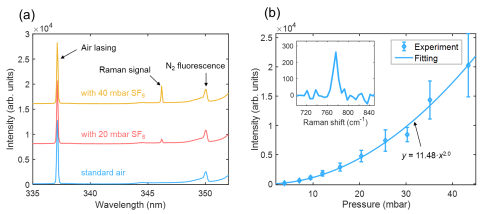Recently, researchers in Shanghai Institute of Optics and Fine Mechanics (SIOM) of the Chinese Academy of Sciences (CAS), developed a novel single-beam coherent Raman scattering technique. With air lasing as a probe source, single-beam coherent Raman spectroscopy can be performed by using a lens and a quarter-wave plate, without the requirement of pulse shaping. This work was published in Optics Letters on Jan. 18, 2021.
In this scheme, Raman coherence prepared by a circularly polarized femtosecond laser is probed by the self-generated narrowband air lasing. The air lasing has a narrow spectral bandwidth, an ultraviolet wavelength, and naturally overlaps with the pump laser. Thus, it is an ideal probe source for coherent Raman scattering.
The air-lasing-assisted coherent Raman technique combines the advantages of femtosecond laser and air lasing. The spectral broadening and pulse self-compression effects during the femtosecond laser filamentation enable coherent excitation of many gaseous molecules. It is thus possible to perform multi-component measurements. Moreover, Raman shifts of different molecules can be well distinguished owing to the narrow spectral linewidth of air lasing.
In addition, the air lasing is located in the ultraviolet region, which not only greatly improves the Raman scattering efficiency, but also makes us easily suppress the supercontinuum background generated by the near-infrared pump laser. The high signal-to-noise ratio ensures the quantitative detection of greenhouse gases. With this method, SF6 gas with a concentration of 0.38% was successfully detected in the SF6-air mixture.
This technique provides a simple and promising route for remote detection, which could be applied to atmospheric detection and combustion diagnosis in the future.

Figure 1. (a) Schematic diagram of single-beam coherent Raman spectroscopy assisted by air lasing. Energy-level diagram of (b) air lasing generation and (c) coherent Stokes Raman scattering. (Image by SIOM)

Figure 2. (a) UV spectra measured in air with and without SF6 gas. The curves have been shifted vertically for clarity. (b) Raman signal as a function of SF6 gas pressure. Inset shows the Raman spectrum from SF6 with the concentration of 0.38 % in the air-SF6 mixture. (Image by SIOM)
Article website:
https://doi.org/10.1364/OL.441602
Contact:
WU Xiufeng
General Administrative Office
Shanghai Institute of Optics and Fine Mechanics, CAS
Email: xfwu@siom.ac.cn
Web: http://english.siom.cas.cn/